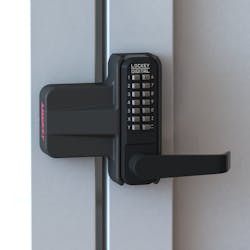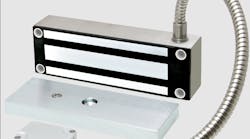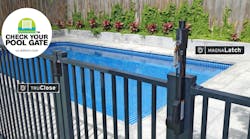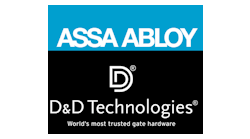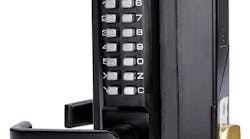Gate work can be interesting, challenging and profitable.
Gates typically are outdoors, but they also can be found in tool cribs, stockrooms and server facilities where visibility and ventilation are as important as restricting movement only to those authorized to access the equipment or protected area.
Outdoor gates control vehicle traffic and pedestrian traffic and try to preserve the privacy and safety of pools, playgrounds, retention ponds and sally ports to name only a few.
Risk assessment of gated areas includes considering the potential for damage or loss to the contents or individuals within, as well as the potential for injury to individuals trying to gain access to the gated area.
Locking gates can be a matter of a simple padlock or a more elaborate system for applications, including access control that uses mechanical, electromechanical or electromagnetic technologies or a combination of these.
Modern science has made technologies, such as wireless and video surveillance, feasible for many more applications than they might have been only a few years ago. This means video surveillance or remote control of gates is possible at a wider range of locations and for a wider range of budgets.
The ability to remotely control and surveil an opening greatly enhances the security management profile of the site.
Rules of Engagement
Gates can be swinging or sliding, but the rules of deployment are the same for both, and similar to those for doors:
- The gate and adjacent walls or fencing must be secure and adequately able to resist attack or normal use.
- The gate and adjacent walls, fencing or barriers must be in good working order. The gate must open and close as designed, for example. The gate should be “balanced,” so with no external equipment, such as chains or control arms, the gate shouldn’t move from whichever position it’s released. This is referred to in some trades as level and plumb.
- If a pedestrian gate is used for access control, the gate ideally should have a self-closing mechanism to close the gate after it’s opened. The hinges must be appropriate for the environment and weight of the gate. Measures must be designed into the system to minimize the possibility of entrapment or injury, bypassing the security or inhibiting free egress from the protected area where required by Life Safety Codes.
In this context, entrapment is when the door or gate strikes a person or object in its path or traps them. Bypassing security is when the locks on a door or gate are designed or mounted so an unauthorized individual can unlock and gain access. Free egress, of course, refers to the universal rule applied to openings that are part of the means of egress, which requires that the door or gate can be opened to allow exit at all times.
There are interesting exceptions to the free-egress requirement that have to be identified and addressed case by case, because approval by the authority having jurisdiction (AHJ) is required. A misapplication can result in personal injury, death and litigation against the property owner and any tradesmen involved even remotely with the building, door or control system.
The regulations that apply to gate safety are readily available but also are revised constantly, so maintaining technical competencies for designing, deploying and servicing gates and gate systems is an ongoing process.
When replacing gate locks, here are a few options to consider:
LockeyUSA 2835-Adapter
The new 2835-Adapter for vinyl and ornamental gates makes it easier than ever to install a 2835 mechanical keyless lever lock on a gate without welding.
The 2835-Adapter installs on gate posts 1-3/4–5 inches thick without requiring an extension kit and accommodates gate gaps of 13/32–1/1-2 inches wide. The adapter is weather-resistant and has reversible handing.
LockeyUSA SUMO GL2 with GL2LINX Adapter
The security of the SUMO GL2 gate lock now can be brought to chain-link fences through the use of the GL2LINX Adapter.
The GL2LINX, sold separately, is an easy-to-install, bolt-on adapter for securing chain-link gates (1-5/8 inches and 1-7/8 inches) with the SUMO GL2 gate lock. The SUMO GL2 is available in single- and double-sided models and offered in two Marine Grade finishes: Jet Black and Satin Chrome.
More info: lockeyusa.com
SDC 1575 / 1576 Series Magnetic Gate Locks
SDC’s magnetic gate locks provide 1,200 pounds of holding force and enable the access and egress control of pedestrian and vehicle gates. Access controls, such as card readers, digital keypads and remote-control stations, provide gate and lock control.
The 1575 for standard mount and 1576 for face-drilled mount magnetic gate locks are compatible with manual and automatic, swinging and sliding, and tubular and iron gates. The floating-armature design compensates for gate misalignment with the electromagnet.
The locks are sealed in an epoxy-filled stainless steel case. A threaded conduit fitting ensures weather-resistant protection of the wiring.
SDC GateLok GL160 / GL260 Series Outdoor Lock
The SDC GL160 and 260 series electromechanical GateLoks are designed to provide access control and remote locking and unlocking capability for manual or automatic chain link, tubular-steel and wrought-iron sliding or swinging gates.
The gate locks are available in fail-safe or fail-secure mode. Locking and unlocking may be accomplished by using an access control, such as a card reader, digital keypad or remote control.
All GateLok models are designed for a 3-inch fence post and 2-inch gate post but are adaptable to smaller sizes.
More info: sdcsecurity.com
Alarm Controls weather-resistant magnetic gate locks
Alarm Controls, an ASSA ABLOY company, provides weather-resistant access control for perimeter applications with its weather resistant magnetic gate locks, the 600WP and 1200WP. These locks are suited to sliding or swinging gates and have 600 pounds (600WP) or 1,200 pounds (1200WP) of holding force.
Each model has all non-aluminum parts plated to resist corrosion and a sealed stainless steel case. The maglocks are 12 or 24VDC and field-configurable, with a current draw of 0.5 amps at 12 VDC and 0.25 at 24 VDC. They can be top mount or side mount through an optional bracket.
More info: www.alarmcontrols.com
Securitron GL1 Gate Lock
The heavy-duty GL1 Electromechanical Gate Lock provides weather-resistant access control for a wide range of gate applications. The surface-mount GL1 provides 2,000 pounds of holding force for electrical and manually operated indoor or outdoor gates where preload is a concern.
Another important feature of the GL1 is that it has no means to readily unlock it manually. A key can be used with the GL1 if a cylinder is installed, but without the key, the GL1 stays locked until actuated, or the power is removed if in fail-safe mode.
Although this is great from a security standpoint, it might raise life-safety issues with the AHJ for some installations. Make sure to check with the AHJ before any installation.
The GL1 operates under preload of up to 100 pounds and has automatic dual voltage so no field adjustment is necessary. Its self-aligning receiver helps to compensate for gate misalignment and sag and has an optional latch-status monitor.
Securitron M62FG-SASM
The M62FG-SASM is a weatherproof face-mount maglock that has conduit fitting and automatic dual voltage, as well as 1,200 pounds of holding force.
The Shock Absorbing Strike Mount (SASM) controls excessive impact between the strike and the maglock, which prolongs the life of the lock, gate and other hardware. SASM is available with the M62FG or as an individual kit to retrofit existing M32, M62 or M82 Gate Magnalock installations.
The M62FG is recommended for high-security perimeter fence gates and electrically operated sliding gates. It includes a patented instant-release circuit, automatic dual voltage and an anti-kickback spring that provides three-eighths of an inch of rebound travel to return the gate to the normal “home” position.
More info: www.assaabloyesh.com
Codelocks Gate Box Kits
Codelocks offers Gate Box Kits for gate and fence installations, which provide a simple and effective access control solution for fenced perimeters and outdoor spaces.
The Gate Box Kit includes a Codelocks lock, latch, 14-gauge steel predrilled weldable box and accompanying hardware. These kits are fully versatile, featuring adjustable strike plates, dual backplate installation options, and exit device hardware and accessories.
Available Codelocks locks include the CL400, CL500, CL600, CL5200 and CL5500 and are suitable for installation on four different types of fencing.
More info: www.codelocks.us
LOCINOX Free Vinci
The Free Vinci is a single-side mechanical code lock for swing gates that have an aluminum housing and a stainless steel mechanism. The Free Vinci provides the ability to secure one side of a gate through a code for entrance while leaving the other side free for exit.
Because the lock is 100% mechanical, no batteries or electricity is required, which makes it easy to equip any gate with access control. The latch bolt has three-fourths of an inch continuous adjustment to allow for perfect alignment of the locking mechanism.
The Free Vinci comes standard with a Club handle for the secure “code” side and a round knob for the exit side. A push handle is available for the exit side. The required latch gap depends on the keep, but standard and security keeps require a 1-1/4-inch latch gap.
LOCINOX Surface-mounted Gate Lock
The Surface-mounted Gate Lock is a high-quality gate lock recommended for industrial gates. The latch and deadbolt have three-fourths of an inch continuous adjustment to allow for perfect latching and locking of the mechanism. A stainless steel throw of seven-eighths of an inch guarantees secure locking.
The required latch gap depends on the keep, but standard and security keeps require a 1-1/4-inch latch gap. For a fast and precise installation, using a Drill-Fix drilling jig is recommended.
More info: www.locinox.com
Tim O’Leary is an experienced security consultant and a regular contributor to Locksmith Ledger.
